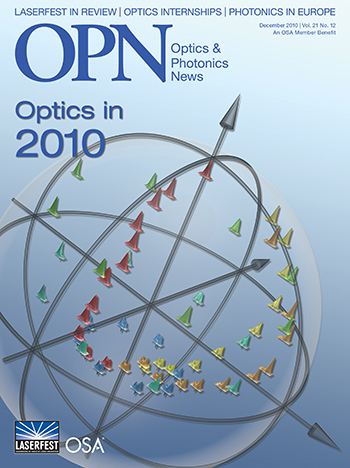
December 2010 Issue
Feature Articles
This special issue of OPN highlights the most exciting peer-reviewed optics research to have emerged over the past 12 months. This year's issue includes 30 summaries representing the work of more than 130 authors from 14 countries.
by GUEST EDITORS: Robert D. Guenther, Judith Dawes, Rongguang Liang, Carlos López-Mariscal and Elena SilaevaPhotonic structures allow control of dispersion in guided wave systems.
New ideas in compressive sensing are expanding our imaging capability. Research that models the retina has led to an understanding of the eye’s acuity.
We have developed interferometric systems to measure nanosize structures and freeze their motion in time. Researchers have also suggested a method to extract both phase and amplitude information for crystallography.
We are developing a better understanding of the fundamentals of novel lasing devices such as the quantum cascade laser and the random laser.
Optical switching has now been made efficient through the use of nonlinear processes.
The use of light for controlling objects led to the development of optical tweezers. Now, the applications have expanded into the creation of three-dimensional structures and the control of surface structures.
Researchers are once again interested in using non-diffracting beams of light because of the possibility
Magnetic interactions with light are usually so small that they are ignored, even in nonlinear optics. Scientists have discovered that parametric processes can drive the interactions to unanticipated strengths.
Plasmonic lenses have been developed for detecting circular polarization.
Quantum information science continues to drive work in quantum optics. New research makes fundamental measurements showing parity-time symmetry breaking using an optical system.
Spectroscopic imaging has become a useful diagnostic tool in biology and chemistry.
A novel method of deflecting an optical beam has produced a new streak camera design.
Departments and Columns
Tripping the Laser Fantastic: A Look Back at LaserFest 2010
As our global celebration of the birth of the laser ends, OSA Past President Tom Baer reflects on the year’s events and festivities—and the 50 years of laser history that preceded them.
Using Rapid Prototyping for Lens Mounts
An optical engineer shares his notes on using rapid prototyping technologies to create lens mounts.
A new treatment for people with damaged corneas may emerge from a study in which corneas regenerated around an implanted collagen scaffolding.
Finding the Right Graduate-Level Internship
Internships are not just for college kids. They’re a low-risk way for graduate students and young professionals to try out various career options and research opportunities.
Photonics has been offi cially acknowledged as a key enabling technology in Europe. Driven by global trends and growing awareness, Europe is experiencing industry growth and an increase in the number of optical societies and public private partnerships that promote photonics applications.
John chronicles the lives of two key Society leaders in the 1950s—a distinguished spectroscopist and a pioneering optical engineer.
Slow-Light Silicon Chip Could Lead to Practical All-Optical Switches
A U.S.-based team has demonstrated the slowest light ever propagated on a single silicon chip.
Laser Technique Moves Particles more than a Meter
In an extension of optical tweezer technology, a new technique guides 100-µm particles more than a meter through air, along a narrow and controllable tube made of laser light.
Optical Clock Leads to Better Measurements of Relativity
Thanks to super-accurate optical clocks, scientists can measure the effects of relativity on ordinary speeds in the everyday world—10 m/s, which is 33 kph or roughly 22 mph.
The Optical Aspects of Graphene Research
Graphene, the one-atom-thick carbon lattice that is the subject of this year’s Nobel Prize in Physics, has many potential applications in photonics—from flexible solar cells and thin-film displays to heat dissipation in tiny optoelectronic devices.
Also in this Issue
Remembering OSA Fellows Carl R. Ingling, Norman J. Brown Jr. and Raymond N. Smartt.


![Manual probe system with needles for test of semiconductor on silicon wafer. [A. Morozov / Getty]](https://opnmedia.blob.core.windows.net/$web/opn/media/images/articles/2025/1125/departments/202511-cover-web.jpg?ext=.jpg)
![Researcher Clara Saraceno in the lab. [Image by Carsten Behler Photography]](https://opnmedia.blob.core.windows.net/$web/opn/media/images/articles/2025/1025/departments/202510-cover-web.jpg?ext=.jpg)
